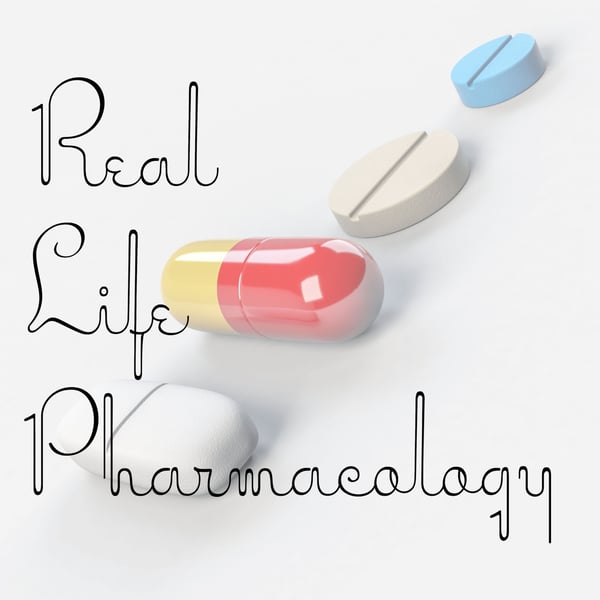Furosemide Pharmacology
Real Life Pharmacology - Pharmacology Education for Health Care Professionals
Eric Christianson, PharmD; Pharmacology Expert and Clinical Pharmacist
5 • 716 Ratings
🗓️ 13 May 2021
⏱️ 16 minutes
🧾️ Download transcript
Summary
If a patient has a new prescription of furosemide, it’s important to look for drug-induced causes of edema. Common causes of drug-induced edema are the calcium-channel blockers (amlodipine, nifedipine, diltiazem, verapamil), some anticonvulsants (pregabalin, gabapentin), pioglitazone, and NSAIDs. In times when oral furosemide is not readily available, 40 mg of furosemide is equivalent to roughly 20 mg torsemide, or 1 mg bumetanide. If IV furosemide is desired and the patient is already on an oral formulation, generally, the approximate equivalent IV dose is 50% of the oral dose. Dosing is approximate and based on urine output. Serum creatinine, electrolytes, weight, blood pressure, should generally be monitored due to the pharmacology of furosemide.
Common adverse drug reactions of furosemide associated with its pharmacology are hypokalemia, and its symptoms such as cramping and uncommonly cardiac problems, hypotension, hyponatremia, dehydration, decrease in renal perfusion, uric acid elevation, transient increases in glucose, angioedema and hypersensitivity reactions, ototoxicity, and nephrotoxicity. Drugs that can exacerbate furosemide’s adverse drug reaction profile are ARBs, ACEis, NSAIDs, aminoglycoside, SGLT2 inhibitors, PDE5 inhibitors, a1a blockers. Electrolyte supplementation may be provided to patients on furosemide to counteract any imbalances that may precipitate.
In cases of overdose, the common symptoms are exacerbations of the adverse drug reactions and mechanism, dehydration, electrolyte imbalances, hypochloremic alkalosis, reduction in blood volume, and hypotension. Supportive treatment of symptoms is necessary to treat furosemide overdoses, fluid and electrolyte replacement is a rational method of treatment. Serum electrolytes, CO2 level, and blood pressure should be monitored in overdose situations. Hemodialysis does not accelerate furosemide elimination.
Show notes provided by Chong Yol G Kim, PharmD Student
Resources
Information taken directly from the podcast episodeDosing goals diuresis end of paragraph 2: 2013 ACCF/AHA guideline for the management of HF https://doi.org/10.1161/CIR.0b013e31829e8776Last paragraph on overdose, furosemide FDA label
Transcript
Click on a timestamp to play from that location
| 0:00.0 | Hey all, welcome back to the real-life pharmacology podcast. I'm your host, pharmacist, Eric Christensen, |
| 0:05.6 | and I thank you so much for listening. As always, go snag your free Top 200 study guide. It's a big |
| 0:12.3 | PDF, 31 pages. I really highlight my most important clinical pearls, things that show up on |
| 0:18.6 | pharmacology exams, as well as board exams, and things |
| 0:23.6 | you're actually going to see in real life. So again, just for subscribing, simple email, you can |
| 0:29.3 | have that resource absolutely for free and we let you know when we've got updates and new content |
| 0:34.2 | and new podcasts available there. So again, real-life pharmacology.com. |
| 0:38.9 | Go check that out. |
| 0:41.1 | Okay, so the drug of the day today is ferrosamide. |
| 0:45.1 | And if you're an avid listener, |
| 0:46.9 | you know I've covered the loop diuretics in general, |
| 0:50.0 | but wanted to get a little bit more detail out there |
| 0:52.8 | specifically about ferrosmide |
| 0:56.0 | in that it is a loop diuretic brand name that you're going to hear in practice is LASIX. |
| 1:03.6 | You know, definitely many, many patients and providers will refer it by the brand name. |
| 1:14.2 | Mechanistically, so being a loop diuretic, that gives you a hint that the loop of Henley |
| 1:23.2 | is impacted. |
| 1:25.3 | So ultimately it inhibits sodium and chloride reabsorption in the ascending loop of Henley, |
| 1:33.0 | and that's in the nephron, of course. That's the considered the functioning unit of the kidney. |
| 1:39.4 | And ultimately, with that loss of solute or sodium and chloride, |
| 1:46.1 | water is going to go with it. |
| 1:48.1 | And that's ultimately what gives you the diuretic effect. |
... |
Please login to see the full transcript.
Disclaimer: The podcast and artwork embedded on this page are from Eric Christianson, PharmD; Pharmacology Expert and Clinical Pharmacist, and are the property of its owner and not affiliated with or endorsed by Tapesearch.
Generated transcripts are the property of Eric Christianson, PharmD; Pharmacology Expert and Clinical Pharmacist and are distributed freely under the Fair Use doctrine. Transcripts generated by Tapesearch are not guaranteed to be accurate.
Copyright © Tapesearch 2025.

